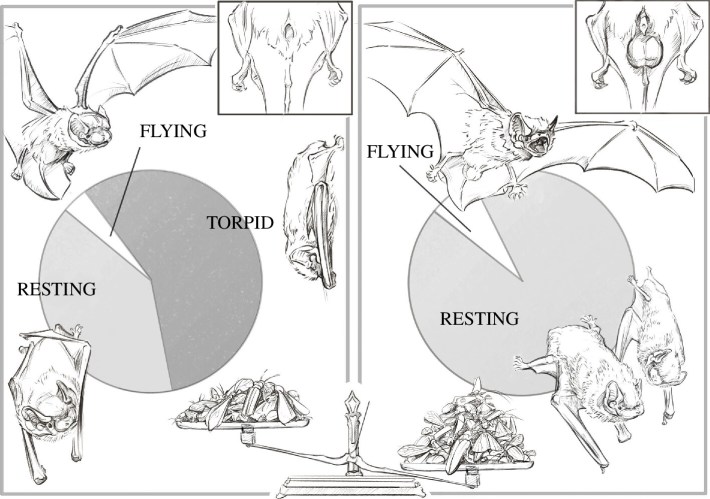In the summer, after the sun sets in the city of Konstanz in southern Germany, the sky fills with bat boys. They are common noctules, or Nyctalus noctula: brown and furry bats that are smaller than a kiwi fruit and about a third of its heft. The female noctules leave town in spring, flying northeast to give birth and raise their young. But the males remain, living in colonies of bachelors—perhaps the most literal instance of a man cave—where they rest, hunt, and produce as much sperm as they possibly can.
It is never easy to be a bat. The animals burn immense amounts of energy during flight, and once they find food, they burn through it quickly, putting them at risk of starvation. All this becomes even more difficult during summertime for male bats, which need even more energy and nutrients to produce massive amounts of sperm—so much sperm that their testicles can increase to up to eight percent of their body mass.
Scientists know very little about exactly how much energy bats consume during an average day, let alone how that changes over the seasons in a year. In the lab, they could place the animals in respirometry chambers to measure how much oxygen a single bat consumes and carbon dioxide it produces. Scientists would need to calibrate that data with that individual bat's heart rate to estimate how much energy it burned during flight. But until recently, researchers did not have the technology to collect high-quality data of a flying bat's heart rate.
In a paper recently published in the journal Proceedings of the Royal Society B, a group of researchers attached custom-made heart-rate trackers that could be carried by a flying bat. They successfully measured the heart rates of male common noctule bats over the course of a few days in the spring and summer of 2020, revealing just how much energy a bachelor bat needs during this hectic testicular time.

First, the researchers had to catch the bats. Lara Keicher, an ecophysiologist at the Max Planck Institute of Animal Behavior in Konstanz, had already studied the energy needs of female common noctules for her PhD research. Catching females at rest was a piece of cake, a matter of plucking a resting bat from a bat box. But in the summer, males more commonly roost in tree cavities, which are harder to reach. "They were also awake throughout the day, so they would fly out as soon as we’d try to pick them out of their roosts," Keicher added. So the researchers caught the bats in mist nets at dusk, when the males would flee their bachelor colonies in the trees.
The researchers took the bats back to the lab to measure their oxygen consumption and heart rates. Then they attached ultra-tiny external heart-rate transmitters, which can be tracked with radio signals, with a special glue that dissolves in a matter of days. The custom-made contraptions were not only light enough to accompany a bat in flight, but also "transmitted a strong enough heart rate signal that was still hearable while the bat was flying and the signal was disturbed by the wingbeats and maneuvers of the bat," Keicher said. Once on a bat, each transmitter emitted a signal that was interrupted by the bat's heart beat, which receivers close by would be able to pick up and record.

After the transmitter was attached, the researchers released the bats back into the wild. But they needed to be close enough to the bats in order to pick up their heartbeats, which sometimes required walking through the forest in search of a signal. Keicher managed this by following the bats on her bike. "I would just bike around to get a heart rate signal, and then set up all the equipment that would track the heart rates throughout the day," she said. This is usually how tracking such signals works—researchers scrambling on the ground to pick up signals from animals in the sky.
But the bachelor bats did not always return to the same roost, and Keicher's bike could only follow the peripatetic mammals so closely. An easier way to track the bats, the researchers realized, would be to meet them in the sky. Luckily, the institute had a small plane used for research to study geese, moths, blackbirds, and other flying animals. Martin Wikelski, the director of the department of migration at the institute, could fly the plane. As COVID-19 had begun sweeping the world, Wikelski and the plane were much more available than usual. "He was kind of having a lot of fun flying with the bats," Keicher said.
For nearly a month in spring, Wikelski tracked bats at night in his small plane, receiver in hand. "From the plane, it's almost impossible to see one particular bat," Keicher said. But the bats occasionally flew in bigger groups to forage for insects over the lake. Researchers from the ground would sit by a roost and wait for a bat carrying a transmitter to emerge. "Then give the information to the pilot and say, 'It just left. Be prepared to find it,'" Keicher said.

The researchers could not fly the plane past 10 p.m., and the tactic raised the hackles of some locals, who wanted to know why a plane had been circling their house so late at night. "We had to explain and answer these angry emails, explaining this is for basic research and it has to do with finding out more about bats," Keicher said. "Which was challenging because it was COVID, so bats were not in the best light."
In the daytime during spring, male bats will go into a state of energy conservation called torpor, in which their heart rate can drop to six beats per minute. But the researchers found that when the bats left the roost to fly, their heart rates leaped from six to up to 900 beats per minute in just a few minutes. In the summer, the researchers were surprised to learn that the bats did not use torpor at all. "We think this was because they were able to feed on enough insects and didn’t need to save so much energy using torpor," Keicher said. Torpor also slows sperm production, which would counteract the bat boys' summer goals: be ready for mating by the time the females come back in the fall.
The researchers found the male bats used 42 percent more energy in the summer than in the spring. To compensate for this energy usage, the bats foraged nearly twice as long and as frequently. The researchers took the heart rate measurements they collected to calculate how many calories the sperm-banking bats would need to eat to forage for that long. They found that a male bat would need to eat up to 33 June beetles or 2,500 mosquitoes in a single night. "If you think they have to forage for more than 30 big beetles every night, that is just a number that is, for me, still really high," Keicher said.
While the requirements of a bat boy summer may be simple—33 June beetles a night, every night—the logistics of achieving it are much more arduous, and may be under threat. All bats must strike a delicate balance between feasting and starving, flying and resting, and having small or ostentatious testicles. This is why it is crucial to know the ins and outs of noctule bat life to predict how the species may fare in the face of rapid environmental change, the researchers argue. The recent, drastic declines in insect populations in the area might make it harder for a bat boy to find the 33 nightly beetles that power his life. "These are just smaller questions that tie into the bigger picture of, if this all changes, how do the bats actually cope with these changes? And how can they adapt?" Keicher said.
If brat summer is about excess—the highest of highs and lowest of lows—and staying up all night, so is bat summer. As you head off into the flashing lights of the club, think of the bachelor bats of Konstanz and their nightly bug quest and wish them luck. After all, one well-fed bat could mean 2,500 less mosquitoes in the world.






